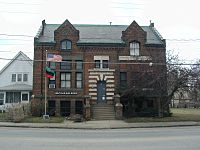Great Plains Black History Museum facts for kids
 |
|
| Established | 1976 |
|---|---|
| Location | 2221 North 24th Street, Omaha, Nebraska |
The Great Plains Black History Museum is a special place that teaches about the history and contributions of African Americans in the Great Plains region. It's located in North Omaha, Nebraska, inside the historic Jewell Building. Before this, it was in the Webster Telephone Exchange Building, which is a very old and important building.
This museum is nationally recognized and has been around for over 40 years. It holds more than 100,000 items. These include old magazines, handwritten papers, photographs, and research materials. The museum often shares its programs and exhibits. It does this in Omaha, across Nebraska, and even in other states when asked. It is the largest museum dedicated to the Black experience in the Great Plains.
Contents
History of the Museum
How the Museum Started
In 1962, a community leader from Omaha, Nebraska named Bertha Calloway started the Negro Historical Society. Later, in 1976, she opened the Great Plains Black History Museum. It was first located in the Webster Telephone Exchange Building. This building had a long history of helping the community. It was a center for recovery after a big tornado in 1913. From 1933 to 1952, it was used by the Urban League as a community center. It offered many services, like medical help and a library.
Why the Museum is Important
For 25 years, Bertha Calloway worked hard. Her goal was to teach people in Nebraska and visitors about the important things African Americans did in the Midwest. In 1996, she explained her mission. She said, "People must see black history for their ideas about Black people to change. That’s what our museum is all about... showing a history that’s been hidden." In 1976, the museum opened with a grant of $100,000. This money came from the United States Bicentennial Commission.
Since it opened, the museum has shown many amazing things. These include paintings, rare books, photographs, and films. All of these tell the story of African Americans in the Midwest. Many African Americans moved to the Midwest from the South. This happened during the first half of the 20th century. It was part of a big movement called the Great Migration. The museum shows how they became city workers. It also shows how churches and other community groups grew. It highlights their music, literature, and other parts of their culture. This museum is one of the largest places dedicated to African-American life west of the Mississippi River.
Changes and New Beginnings
The museum faced some challenges and closed its main building in 2001. This happened because the director, Jim Calloway (Bertha Calloway's son), felt they did not get enough money. They had relied on funding from the City of Omaha and Douglas County. The building needed repairs. The museum considered moving or holding exhibits in other places.
The museum arranged for the Nebraska State Historical Society to temporarily care for its materials. Their staff worked to organize documents and photos. By 2010, the museum reorganized with a new board of directors. In the spring of 2011, they started holding community meetings. These meetings discussed the museum's future. They even talked about showing materials before a new museum building was ready. As the new president, James Beatty, said, "The building is closed but the museum is open!"
In 2014, the museum moved to a space in the Crossroad Mall. It stayed there until 2017. Then, the museum moved to a larger space. This new home was on the first floor of North Omaha's historic Jewell Building. This is its current location at 2221 N. 24th Street. The museum now hosts many exhibitions each year. It also offers public programs for everyone to enjoy.
In 2022, the museum gave the Webster Telephone Exchange Building to the Bertha Calloway Foundation. This foundation helps continue Bertha Calloway's important work.
See also

